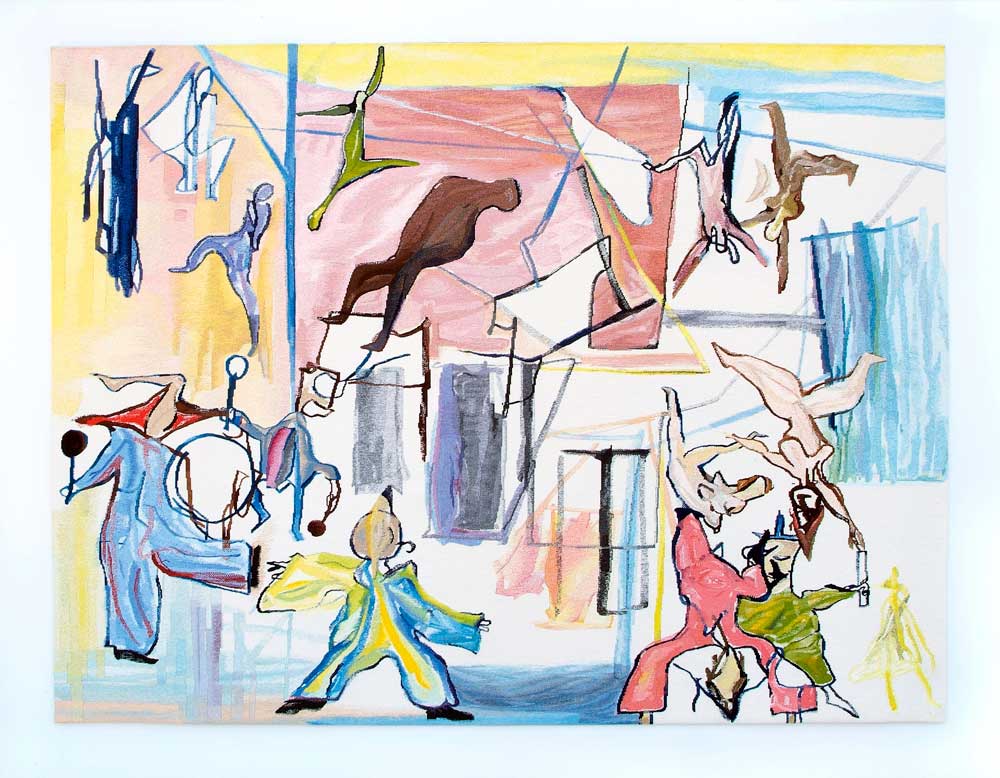



Circus V, designed by Ken Whisson in 2006, was woven to celebrate the contribution to the arts made by Sir Rupert Hamer, former Premier of Victoria and Minister for the Arts.
Born in 1927, Whisson is a distinguished Australian artist. Whisson created the painting Circus V in early 1985. It is typical of his work, in that it simultaneously imparts a sense of spontaneity and order, based on the subjective stimuli of memory and intuition.
The ATW (formerly known as the Victoria Tapestry Workshop) was established by the Victorian Labour Government in 1976, following a feasibility study commissioned by Sir Rupert when he was Victorian Arts Minister. The tapestry was woven to be a major feature of the National Circus Centre — a project close to Sir Rupert’s heart, and one he worked passionately to raise funds for up until his death in 2004.
Throughout the translation process, the weavers sought to emphasize the dynamic linear qualities of the painting. The limited colour palette offered many subtle shifts and changes. The overall feeling of light was important to the tapestry design and great care was taken in the selection of white tones used throughout the background.
Open world, designed by John Young in 2005, was commissioned by the State Government of Victoria as a gift from the people of Victoria to the people of Nanjing in China, marking the 25th anniversary of the sister-city relationship between Nanjing and Melbourne and to celebrate the completion of the then new Nanjing Library.
Young, who was born in Hong Kong in 1956 and moved to Australia in 1967, explores his own artistic and cultural history through his practice, while responding to issues in Australian art history.
Open world is a composite image incorporating Australian and Chinese references. The background is of an 18th-century Chinese tapestry in reverse, depicting foreigners offering gifts to a Chinese ruler. A cluster of photographic imagery lines the edges of the tapestry: a Eurasian women in a Chinese wedding dress; Victoria’s Great Ocean Road; a cloudscape; and pictures of the cherry blossom (native to Nanjing province) and pink heath (Victoria’s floral emblem). The surface is dotted with Chinese calligraphy and the names of lands discovered by the 15th-century Chinese explorer, Admiral Zheng He. The Chinese characters layered over the top of the design are previous historical names for Nanjing. Young arranged for these names to be written by a Chinese calligrapher in the appropriate script for the historical period in which the name was used. There are also three words in English mirroring the Chinese, Kulin Nation, Naarm and Bareberp, which are all Aboriginal/Koori names for Melbourne/ Victoria.
In its bicultural references Open World continues to examine Young’s evolving exploration of transcultural concerns and the diasporic experience.
In 2004 the ATW wove Gulammohammed Sheikh’s Mappamundi — a design composed from a melting pot of Eastern and Western history, juxtaposed on an image of a map— visual components that are now synonymous with Sheikh’s wider practice.
Sheikh’s fascination for painted maps was triggered by a picture postcard he found in the British Library bookshop of a 13th-century map of the world, known as the Ebstorf Mappamundi. When Sheikh learned that the original parchment map was destroyed during the allied bombing in World War II, he used the image as inspiration for making his own world maps. Over five years Sheikh created approximately 15 versions of Mappamundi, each a celebration of Eastern and Western culture, history and contemporary events. His Mappamundis& feature stylistic influences, ranging from Ambrogio Lorenzetti and Piero della Francesca to Mughal painting, and contain a medley of Hindu and Muslim references to religious ritual, family customs, Indian village life and contemporary events, such as the destruction of the Bamyam Buddha in Afghanistan. The Mappamundi tapestry depicts the map framed in each corner by the symbolic figures of Mary Magdalene reaching out to Christ, Kabir weaving the shroud, Rama chasing elusive deer and a mad mystic, dancing. By an uncanny coincidence, the dimensions of the finished tapestry resemble those of the original, lost Ebstorf Mappamundi.
Gulammohammed Sheikh has exhibited widely in major international institutions.